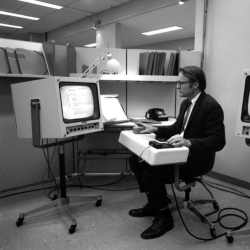William English, one of the creators of the mouse back in the 60s, passed away last week. And that got me thinking of how amazing it would have been to be in the place that was inventing what would become modern computing interfaces. What a special time! Of course, they probably had no idea.
 From here, it looks like the mouse changed everything, but you have to realize that they were working in a world with light-pens, where you could actually draw on the screen. In contrast, the mouse seems positively non-futuristic. They must have known they’d come up with an improvement over the status quo, but did they know they’d created a revolution?
From here, it looks like the mouse changed everything, but you have to realize that they were working in a world with light-pens, where you could actually draw on the screen. In contrast, the mouse seems positively non-futuristic. They must have known they’d come up with an improvement over the status quo, but did they know they’d created a revolution?
So where has the revolutionary spirit in DIY human interface devices gone? I’d claim it’s still alive and kicking. Indeed our own Kristina Panos has a series called “Inputs of Interest” and we’ve seen a ton of DIY keyboards of late. Then there are many varieties of dial inputs. I used to have a dedicated scroll wheel made out of a hard-drive platter, and when I was reading lots of PDFs on-screen, I have to say it earned its desk-space. Heck, we’ve even seen people make their own mouse.
But what I love about the story of the development of the mouse is that they asked the question “what is the best way to locate a point on a screen” and tried to answer it. Half of their success is probably in simply asking the right question, and the other half in prototyping something half-workable. My gut says that we don’t have inputs figured out 100% on mobile yet. This sounds like a job for Hackaday. What’s the next big human-interface design need? And have you got any crazy ideas to solve it?
Hackaday Remoticon
And this week, we announced the Hackaday Remoticon, our shelter-in-place version of the Supercon. It’s going to take place in November as usual, but online instead of IRL.
The good news? It’s going to be chock full of workshops, all streamed online and recorded for posterity. And for that we need your proposals. If you’d like to teach a group of distributed hackers learning your favorite techniques and tricks, this is your chance!
The bad news is of course that we won’t get to see you all in person. That’s going to make the 2021 Hackaday Supercon seem even more super.

















Now I’m sure, hackaday is getting us duplicated posts. I clearly remember reading this a few days back. The only thing different is the cover image, it wasn’t that stylized neon art.
OMG conspiracy!!!!1111oneone
“This article is part of the Hackaday.com newsletter, delivered every seven days for each of the last 200+ weeks. It also includes our favorite articles from the last seven days that you can see on the web version of the newsletter.”
you missed a horrible, horrible step between light pen and mouse
the “bit pad”, especially the BitPadOne things that were bigger than A3
friggen autocad
grumble, grumble
I think those were introduced well after mice were common — pretty sure originally they were meant for digitizing physical drawings point-by-point (but rather overstayed their welcome)
I believe they were around in mid 1970s for the dozen filing cabinet sized early commercial CAD systems. They later appeared for PCs when there was a killer app to make them useful.
Isn’t the bitpad basically an early version of a drawing tablet, which is a wonderful pointing device (for some purposes)?
It really was not such a new idea. The analog Mk. 5 Target designation system used joysticks to position symbols on a radar display to designate targets to the fire control systems. An older idea adapted to new technology
mark 5 target designation.
The airplane wasn’t a new idea either as human early on used boats to move from place to place.
I’ve got something “different” in the pipeline. It came from a starting point of “What if thumb keypads worked with full size thumbs, and had tactile feedback…” I don’t want to oversell it, so I’ll just say it could do for thumb keyboards, what Segway did for urban transport. ;-)
Though just this minute, another thumb input device idea sprang forth, which also might be a goer… that one could even be Sinclair C5 level.
On a more whimsical note, I also just had a picture in my head of the old Dymo labeller input method, spin the wheel and squeeze to crimp… That would be kind of fun to implement. Maybe a Grey coded wheel, and depress switch or squeeze handle or trigger to read it from the opto sensors, or other sensors (Hall effect works with suitable notched steel code wheel) or contacts or switches. Opto would be nice and smooth though, you could have offset finger spinning hole and make it nicely weighted like the tuning knob on some classic radios. Think it has the potential to not be as bloody awkward as it first sounds. Could have multiple switches for shifts and modifiers. Damn, now I’m thinking serious about a Dymo labeller air mouse and wheel keyboard for TV boxes…
If you like the Dymo interface you’ll love the Wheel!
https://www.youtube.com/watch?v=9BnLbv6QYcA
…which was, of course, rendered obsolete by this one https://www.youtube.com/watch?v=BGGOn-H7s3Q
Points for a funny article picture!
If you think light pens were futuristic compared to mice, you probably haven’t ever used a light pen. I had a few opportunities to work with them in the ’80s and they were pretty clunky.
Weirdly, our local library’s text-baed electronic card catalog used them. What an odd decision, in retrospect.
Did they use them for barcodes on books and cards as well originally? I recall those types of systems from the late 80s before they got the checkout type laser scanners.
I have used one. The real problem is that you don’t want to be holding your arm straight out to the damn screen. It’s endurance exercise to do more than a few minutes’ work. I’ve seen them with screens embedded in the table, though, so maybe that’s a starter? You end up with an old-tech Cintiq, I guess.